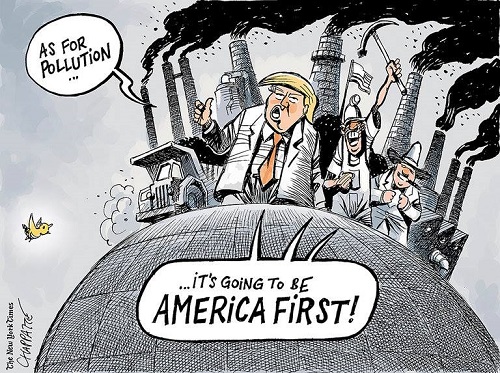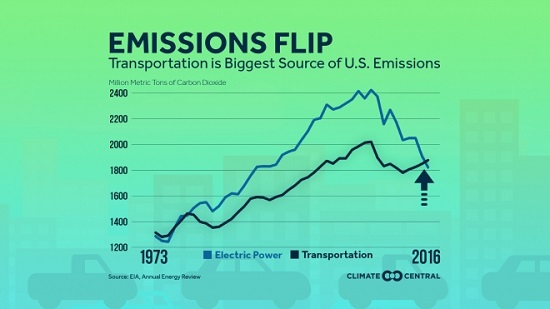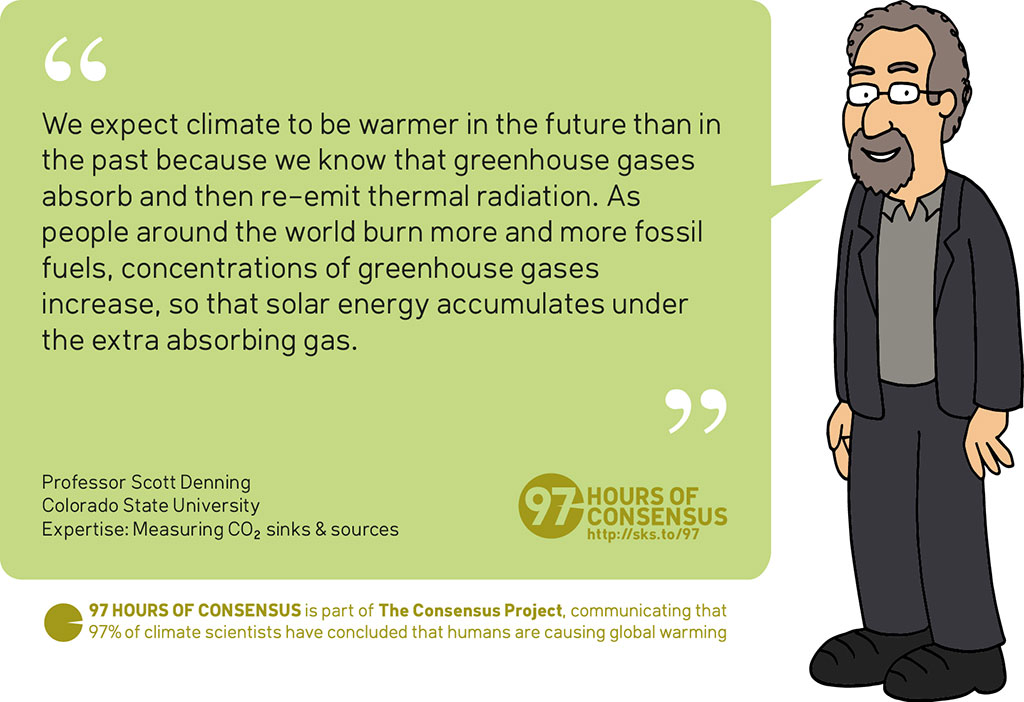2017 SkS Weekly Climate Change & Global Warming Digest #47
Posted on 26 November 2017 by John Hartz
Story of the Week... Analysis of the Week... Editorial of the Week... New SkS Rebuttal Article... El Niño/La Niña Update... Toon of the Week... Graphic of the Week... Photo of the Week... SkS Spotlights... Video of the Week... Coming Soon on SkS... Poster of the Week... SkS Week in Review... 97 Hours of Consensus...
Story of the Week...
Can Carbon-Dioxide Removal Save the World?

Photo-Illustration by Thomas Albdorf for The New Yorker
Carbon Engineering, a company owned in part by Bill Gates, has its headquarters on a spit of land that juts into Howe Sound, an hour north of Vancouver. Until recently, the land was a toxic-waste site, and the company’s equipment occupies a long, barnlike building that, for many years, was used to process contaminated water. The offices, inherited from the business that poisoned the site, provide a spectacular view of Mt. Garibaldi, which rises to a snow-covered point, and of the Chief, a granite monolith that’s British Columbia’s answer to El Capitan. To protect the spit against rising sea levels, the local government is planning to cover it with a layer of fill six feet deep. When that’s done, it’s hoping to sell the site for luxury condos.
Adrian Corless, Carbon Engineering’s chief executive, who is fifty-one, is a compact man with dark hair, a square jaw, and a concerned expression. “Do you wear contacts?” he asked, as we were suiting up to enter the barnlike building. If so, I’d have to take extra precautions, because some of the chemicals used in the building could cause the lenses to liquefy and fuse to my eyes.
Inside, pipes snaked along the walls and overhead. The thrum of machinery made it hard to hear. In one corner, what looked like oversized beach bags were filled with what looked like white sand. This, Corless explained over the noise, was limestone—pellets of pure calcium carbonate.
Corless and his team are engaged in a project that falls somewhere between toxic-waste cleanup and alchemy. They’ve devised a process that allows them, in effect, to suck carbon dioxide out of the air. Every day at the plant, roughly a ton of CO2 that had previously floated over Mt. Garibaldi or the Chief is converted into calcium carbonate. The pellets are subsequently heated, and the gas is forced off, to be stored in cannisters. The calcium can then be recovered, and the process run through all over again.
“If we’re successful at building a business around carbon removal, these are trillion-dollar markets,” Corless told me.
Can Carbon-Dioxide Removal Save the World? by Elizabeth Kolbert, Annals of Science, The New Yorker, Nov 20, 2017 Print Edition
Analysis of the Week...
Trump’s withdrawal from the Paris agreement means other countries will spend less to fight climate change
A six-meter high replica of the Statue of Liberty made by Danish artist Jens Galschiot at the 'Climate March' demonstration prior to the UN Climate Change Conference COP23.
The recent round of U.N. climate negotiations ended Friday in Bonn, Germany. While no important decisions were made on climate finance — transfers from wealthy to poor countries to support climate mitigation and adaptation — the question of who pays for global climate gave rise to heated debates.
Formally a technical meeting to finalize the design of the 2015 Paris agreement on climate change, the summit was the first after President Trump’s June 2017 announcement to withdraw from the deal.
Trump’s decision leaves the United States alone outside the Paris agreement. While U.S. noncooperation shouldn’t deter other countries from pledging climate action, my recent research with Thijs Van de Graaf shows that it threatens industrialized countries’ promises of climate finance for mitigation and adaptation in poorer countries.
Trump’s withdrawal from the Paris agreement means other countries will spend less to fight climate change, Analysis by Johannes Urpelainen*, Monkey Cage, Washington Post, Nov 21, 2017
*Johannes Urpelainen is the Prince Sultan bin Abdulaziz Professor of Energy, Resources and Environment at the Johns Hopkins School of Advanced International Studies. He is also the founding director of the Initiative for Sustainable Energy Policy (ISEP).
Editorial of the Week...
As climate talks end, it is time for action

A Greenpeace protest balloon at the United Nations climate-change meeting in Bonn, Germany.Fotoholica Press/Getty
It will not go down in history as a great moment of climate diplomacy. But the United Nations climate talks in Bonn, Germany, that ended last week did have their moments. One was the indignant jeering with which audience members and protesters met a White House delegation attempting to justify US President Donald Trump’s take on climate and energy policy. Otherwise, two years after the triumph of reaching the Paris agreement on climate change, delegates were largely preoccupied with the important work of finessing the rules and technicalities of that landmark deal.
As climate talks end, it is time for action, Editorial, Nature, Nov 20, 2017
New SkS Rebuttal Article...
Climate scientists would make more money in other careers by Dana Nuccitelli, Skeptical Science, Nov 24, 2017
El Niño/La Niña Update
The Australian Bureau of Meteorology issued a La Nina alert Tuesday meaning conditions in the Pacific Ocean have just about reached the point where the weather-roiling phenomena is about to get cracking. But wait, just two weeks ago the U.S. said a La Nina had started. What’s behind the conflicting signals?
It turns out the U.S. and Australia use different criteria to determine when one La Nina milestone is reached. For the U.S., its a drop in sea-surface temperatures of 0.5 degrees Celsius (0.9 Fahrenheit) below the 1981-2010 average. Australia waits for a 0.8 degree Celsius drop from the 1961-1991 average. And though Australia is switching to the newer temperature set, which reflects the warming of the Earth since 1961, it will still wait for a 0.8 degree drop, meaning the U.S., on occasion, will declare a La Nina before their Aussie counterparts.
One Ocean, Two La Nina Forecasts: A Look Behind the Numbers by Brian K Sullivan, Bloomberg News, Nov 21, 2017
Toon of the Week...

Graphic of the Week...

Transportation is the Biggest Source of U.S. Emissions, Climate Central, Nov 21, 2017
Photo of the Week...
Climate change activists march before COP23 United Nations talks
Protesters carry giant globes with inscriptions 'Stop coal' and "Save the Climate' during the 'Climate March' demonstration.
Source: Slide show appended to the article, California's Jerry Brown on how to beat Trump on climate change by Sonya Angelica Diehn, Deutsche Welle/USA Today, Nov 13, 2017
SkS Spotlights...
![]()
ISEP – the Initiative for Sustainable Energy Policy – is an interdisciplinary research program that uses cutting-edge social and behavioral science to design, test, and implement better energy policies in emerging economies.
Hosted at the Johns Hopkins School of Advanced International Studies (SAIS), ISEP identifies and pursues opportunities for policy reforms that allow emerging economies to achieve human development at minimal economic and environmental costs. The initiative pursues such opportunities both pro-actively, with continuous policy innovation and bold ideas, and by responding to policymakers’ demands and needs in sustained engagement and dialogue.
A unique feature of ISEP is the pragmatic recognition of the administrative, political, and socio-cultural constraints on policy reform. The initiative is based on the premise that the obstacle to energy policy reform is rarely the lack of better alternatives to the current situation, but rather the vexing difficulty of enacting, implementing, and sustaining these alternatives. We adopt a balanced method that considers both sustainability and access to energy crucial priorities, and conduct rigorous research for evidence-based policy advice.
Video of the Week...
James Hansen, Pam Peterson, and Philip Duffy join us to discuss how the hesitancy among scientists to express the gravity of our situation is a major block to our understanding and response to climate change, The reticence results from a combination of factors: political pressure, institutional conservatism, the desire to avoid controversy, aspiring to objectivity, etc. But when the data and the conclusions it leads to are alarming, isn't it imperative that the alarm be transmitted publicly? Here is another facet of society's apparent inability to assess and respond appropriately to the present immense, existential threat of climate change.
James Hansen - Scientific Reticence: A Threat to Humanity and Nature, YouTube Video by United Planet Faith & Science Initiative (UPFSI), Nov 19, 2017
Coming Soon on SkS...
- American leaders should read their official climate science report (John Abraham)
- COP23 video: Three need-to-knows from the UN climate talks in Bonn (Rosamund Pearce & Jocelyn Timperley)
- New study uncovers the 'keystone domino' strategy of climate denial (Dana)
- Impact of climate change on health is ‘the major threat of 21st century’ (Daisy Dunne)
- New research this week (Ari )
- 2017 SkS Weekly Climate Change & Global Warming News Roundup $48 (John Hartz)
- 2017 SkS Weekly Climate Change & Global Waming Digest #48 (John Hartz)
Poster of the Week...

SkS Week in Review...
- 2017 SkS Weekly Climate Change & Global Warming News Roundup #47 by John Hartz
- New research, November 13-19, 2017 by Ari Jokimäki
- New rebuttal to the myth 'climate scientists are in it for the money' courtesy of Katharine Hayhoe by Guest Author
- Analysis: WRI data suggests emissions have already ‘peaked’ in 49 countries by Zeke Hausfather (Carbon Brief)
- Video: Climate, Sea Level, and Superstorms by greenman3610 (Climate Denial Crock of the Week by Peter Sinclair)
- Battered by extreme weather, Americans are more worried about climate change by Dana Nuccitelli (Climate Consensus - 97%, Guardian)
- 2017 SkS Weekly Climate Change & Global Warming Digest #46 by John Hartz
97 Hours of Consensus...

Quote derived with author's permission from:
"But our expectations of future warming are not based on extrapolation of recent trends. Rather, we expect climate to be warmer in the future than in the past because we know that greenhouse gases absorb and then re-emit thermal radiation. As people around the world burn more and more fossil fuels, concentrations of greenhouse gases increase, so that solar energy accumulates under the extra absorbing gas. Scientists expect accumulating heat to cause warming temperatures because we know that when we add heat to things, they change their temperatures."































 Arguments
Arguments






























Regarding negative emissions technology, the economist.com has a good article here. This covers sucking CO2 from the atmosphere with chemical processes, beccs, enhanced soil sinks, and forestry sinks.
The calcium process is near instant removal of emissions, but would clearly be energy intensive, and would have to use renewable energy otherwise you are just burning fossil fuels to then remove the same carbon. So it needs a lot of links in the chain to be properly in place.
The main thing bugging me is the article didn't give much idea of availablity of suitable geological formations to store all the carbon, dioxide, and whether these are in useful locations.
Unfortunately, the past and current lack of leadership in Business and Politics to limit the negative future consequences of current day pursuits of Private Interests has resulted in economic Private Interests significantly compromising the Global Public Interest of developing lasting benefits for humanity.
The obligation of the current generation of humanity to stop allowing Private Interests to compromise the Public Interest is undeniable. Expecting 'Others' to deal with a problem that is being created by the Private Interests of a current generation of humanity in pursuit of enjoying a better present for themselves is undeniable unsustainable harmful activity. No Real Good Reason can be offered to support that type of attitude.
And the current generation, particularly the most fortunate among the current generation, have an obligation to do the most to undo the damage already done by developed human activity. And it is fairly well established that responsible respectable human action would rapidly reduce CO2 levels to 350 ppm (kudo's to the likes of Bill and Melinda Gates).
The above is presented as the basis for the following: Until a 'truly sustainable profitable economic system' develops to remove carbon from the atmosphere, the most effective methods for doing this must be paid for by government funded actions Not For Profit. A 'profitable' system to remove carbon may never develop. What possible economic use can be made of carbon extracted from the atmosphere where the extraction of the carbon is more cost-effective than other sustainable methods of obtaining that carbon?
I agree with Dr. Kevin Anderson when it comes to any form of geo- engineering and carbin capture. To paraphrase, his viewpoint is that we should research carbon capture & storage, but we must not assume it will work at scale - which it has yet to do so so far - and it should not be included in any of the IPCC emission scenarios. Instead, as he points out, we should be putting our time, effort, money and energy into rapid and large-scale mitigation and decarbonization measures that will reduce - not stabilize, but actual reduction - of carbon emissions. Frankly, to pin our hopes on truly untested and pie-in-the-sky scenarios to save our "non-negotiable" and profligate way of life here in the west is not only sheer stupidity of the highest order, but, in my opinion, tantamount to genocidal crimes against all life on this planet, not just us.
Carbon capture is very desirable to help combat the climate problem, but no one single carbon capture method is going to be sufficient alone. The calcium carbonate option ( and other similar approaches)should clearly be researched, but is expensive, energy intensive, complicated, blue sky technology and I agree it would be unwise to count on it. However it has the virtue of absorbing emissions fast, and doesn’t require much land area.
Forest sinks run out of enough land, and so will bccs solutions. Improved soil sinks are a very attractive natural proven option, but will be very slow to scale up, and carbon draw down can be slow.
But all options do have value especially in initial phases until they come towards various limiting factors. If you combine all of these in a planned way, it could well absorb emissions enough and be cost effective. Given countries have different geographies you can’t generalise on which is best option, but it would be possible to design a good combination of options for individual countries (like Jacobson has done with renewable energy).
But it’s hard for me to see governments agreeing a plan, especially when it involves a combination of methods. Democracy, lack of individual commitment, and varying human political ideologies were not designed for this sort of environmental crisis.
Glixon@4,
I agree that ending human activity that increases CO2 in the atmosphere is the top priority and must be achieved quickly.
The second point is that the current generation owes future generations no more than 350 ppm CO2 in the atmosphere. That means the current generation has to start removing carbon before it stops adding carbon, but never believe that because they are removing carbon it is acceptable for them to add more CO2.
That removal of CO2 will not be a 'money maker', and should not be a money maker unless a truly sustainable profitable activity is developed. Businesses/investors should not make a profit by being collectively paid by the collective of governments to reduce the CO2. And the businesses and investors making profit from the burning of fossil fuels should be paying the majority of the costs to remove CO2, again without the removers making any profit.